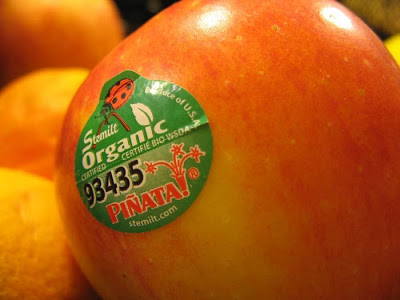
Why the Little Sticky Label on Fruit?
Karma Metzgar, C.F.C.S.
Former Northwest Regional Nutrition Specialist
Nodaway County Extension Center
University Outreach and Extension
Missouri Families - Food and Fitness
11 November 2003
source
Have you noticed the little "brand" stickers on your bananas, apples, peaches, pears, mangos, kiwi, and other seasonal fruits? Those stickers are helpful for the store clerk, as they don't have to distinguish the difference between Fuji apples from Gala apples. That little helpful sticker has the price look up (PLU) code to speed up the check out process. But did you know that look up number also tells you more? Do you want to know what?
The number on that little sticker, not only is the price look number, it also tells how the product is grown or created. This has made news recently with the release of the new rules for "organic" labeling. For conventionally grown fruit, the PLU code on the sticker consists of four numbers. Organically grown fruit have a five-numeral PLU beginning with the number 9. Genetically engineered fruit has a five-numeral PLU beginning with the number 8.
When I read about this labeling, I decided to scout my refrigerator for the little stickers. The bananas and apples both were four digits-meaning conventionally grown fruit.
So using this numbering system, a conventionally grown banana would be 4011, an organic banana would be 94011 and a genetically engineered banana would be 84011. Interesting isn't it?
Who developed this numbering system? The numeric system was developed by the Produce Electronic Identification Board, an affiliate of the Produce Marketing Association, a trade group for the produce industry.
While the stickers are helpful to the cashiers to accurately identify and price produce, there are plenty of complaints about how well the stickers stick!
According to the Produce Marketing Association, some shippers have begun using stickers designed with tabs that make them easier to lift off, and are buying equipment that applies adhesive to the sticker but not to the tab.
Companies are also experimenting with different sticker materials, such as vinyl, that hold up under a variety of temperature and moisture conditions.
The adhesive now used to attach the stickers is food-grade, but the stickers themselves aren't edible. To remove stubborn ones, soak in warm water for a minute or two. As a kid, we used to argue over who got the sticker off the bananas to wear as tattoos! They weren't a problem; just not enough on a bunch.
So the next time you pick up that kiwi, melon, pineapple, apple or banana, check out the numbering system. Is it conventionally or organically grown? Or, is it a result of genetic engineering? It's all in the number-which also is the price look up code for the cashier. A simple number for a complex situation.
Copyright © 2003 Karma Metzgar
Copyright © 2003 MissouriFamilies.org
Reprinted for Fair Use Only.


No comments:
Post a Comment